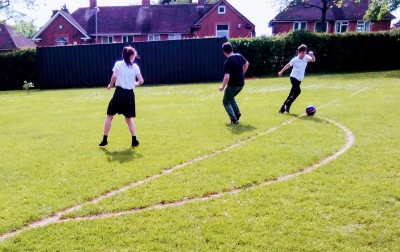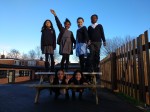Mrs Gibbs has worked at Paganel Primary School since the school changed from being two separate schools to one, and helped saved our earliest archives from literally being thrown away. Continue reading
Author Archives: Marcus Belben
Learning about our suffrage heritage
It’s important to know where your from. It’s also important that where you’re from recognises and values you.
We started this week with a political map of Birmingham, showing boundaries about to change, discussed why they were changing, discussed the biggest change in Birmingham Political history in 1911, when the Greater Birmingham Act made us ‘the second city’, and the biggest national political change on February 6th 1918, when the Representation of the People Act was signed on 6th February 1918, giving the right to vote to most men and, for the first time, some women.
In the playground
Following the interviews, we decided to go out into the playground and photo some of the things discussed. Here are some of the comments:
‘We’ve had a lot of fun here’
‘This is where the foxes live – we’re not allowed to go too close.’
‘We use the tables for hiding under – they have games on top.’
‘When we were little we got to go the little playground. We’ve not been here for years!’
‘In year 2 we did PE here [the small playground]’
‘I remember growing vegetables and eating them. Make soup and parents had to try it.’‘In nursery we used to play on the bikes. Brings back memories of crashing into the wall and hurting myself, so many times.’
What it’s like as a Pupil at Paganel
We ran a series of short interviews with students about what it’s like being at Paganel School. Paganel Archives club talked about lunchtime, the playground, discipline at the school among other things – have a listen to the interviews below:
Visiting Lodge Hill Cemetery
On 10th November our Year 5 visit to Lodge Hill Cemetery using in soldiers footsteps to find out about World War One in Birmingham. Afterwards we asked a teacher and some of the children about the visit. Video and sound clip are brief edited responses: Continue reading
Visit to the University
‘It’s the best trip we ever had because it was four trips all together’.

This blog is about the University of Birmingham visit by Paganel Primary Year 6 and was written by Archives After-school club, yr6:
We went to University of Birmingham and looked around ‘Old Joe’ the clocktower and walked around the old building. The clock tower has LED lighting so it can go different colours.
Then we went to the Barber Institute, in the middle of the University. It was very nice because Mrs Barber donated so many pictures and still helps it run after she’s died.
 We looked more at some of the self-portrait paintings. It was interesting to find out what they meant. Like the one where the man was in black and holding a skull. When you look at it at first it’s just a portrait, but when read what’s underneath and look a little harder you can see more what it means.
We looked more at some of the self-portrait paintings. It was interesting to find out what they meant. Like the one where the man was in black and holding a skull. When you look at it at first it’s just a portrait, but when read what’s underneath and look a little harder you can see more what it means.
One picture was unknown who it was, and it was a picture of a woman who had sorrow on her face. I was curious about who it might be and why they were sad, because there wasn’t much known about it.
There was a painting of Jesus with the dark soldier next to him. It looked like a demon behind him, all black with a scary face. I like scary stuff, it’s fascinating and I want to know more about it.
‘Then we went to the archives. This was my favourite bit.’
When we visited the people at Cadbury Research Library. They had all the archives locked up downstairs, all protected. They showed us how they conserved it by bathing the paper in water. They ‘relaxed’ the paper by spraying it before the bath (see photo top of page).
 We also saw a letter written by Neville Chamberlain to Adolf Hitler before the second world war, as well as lots of other archived things.
We also saw a letter written by Neville Chamberlain to Adolf Hitler before the second world war, as well as lots of other archived things.

Roary the Allosaurus
At the Lapworth museum we met Roary the Allosaurus. He broke two bones in his ribs and toe, so he couldn’t fight and he couldn’t eat, and that’s why he died.
I liked the crystals, the stuffed animals and the fossils. There was a stuffed possum too.
Make sure you visit the University and all the free places you can go and find out things too.
Please visit uni and see more of our photos in our archive, or see last year’s visit blogpost.

Where to from Paganel?
 I asked our Year 6 Archive After-school club members three questions about what they want to do, where they want to live and a favourite moment or advice for people starting Paganel. Here’s what they said:
I asked our Year 6 Archive After-school club members three questions about what they want to do, where they want to live and a favourite moment or advice for people starting Paganel. Here’s what they said:
Continue reading
Teaching – that’s the life for me!
 Mrs Jackson explains about her last job, teaching on a boat. There were different challenges to teaching – often there was a wider age range – and returning back to teaching in the UK after a period of time a lot of things had changed, or was new, like phonics. Continue reading
Mrs Jackson explains about her last job, teaching on a boat. There were different challenges to teaching – often there was a wider age range – and returning back to teaching in the UK after a period of time a lot of things had changed, or was new, like phonics. Continue reading
Teaching – Married in the job
 Mrs Lovell explains about her favourite moment at Paganel Primary School when she was married by the Headteacher.
Mrs Lovell explains about her favourite moment at Paganel Primary School when she was married by the Headteacher.
What it’s like being a Teaching Assistant
 Paganel Archives After-school club interview Mrs Sanders who is a Teaching Assistant at Paganel Primary School. Mrs Sanders explains why she doesn’t want to be Head Teacher at Paganel Primary School. She talks about what she enjoys about her job: Continue reading
Paganel Archives After-school club interview Mrs Sanders who is a Teaching Assistant at Paganel Primary School. Mrs Sanders explains why she doesn’t want to be Head Teacher at Paganel Primary School. She talks about what she enjoys about her job: Continue reading









